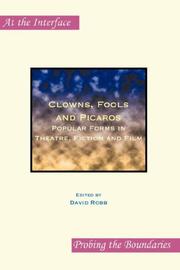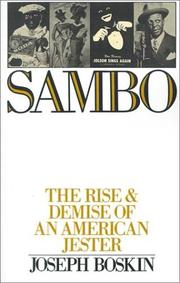| Listing 1 - 10 of 12 | << page >> |
Sort by
|
Book
ISBN: 144389429X 9781443894296 9781443890502 Year: 2016 Publisher: Newcastle upon Tyne, England : Cambridge Scholars Publishing,
Abstract | Keywords | Export | Availability | Bookmark
 Loading...
Loading...Choose an application
- Reference Manager
- EndNote
- RefWorks (Direct export to RefWorks)
To prepare for the role of the Joker, Heath Ledger locked himself in a London hotel room, trying to understand and become a character he saw as "an absolute sociopath, a cold-blooded, mass-murdering clown" who was not intimidated by anything and found all of life "a big joke." In the end, Ledger's obsession with his role contributed to his own death from drugs before The Dark Knight was released. The connections and irony are too close to ignore. The movie gives the world a curious twist on the roles of Batman and the Joker. It's politically incorrect, and yet emotionally the Joker's insanity
Book
ISBN: 0826356672 9780826356673 9780826356666 0826356664 Year: 2016 Publisher: Albuquerque
Abstract | Keywords | Export | Availability | Bookmark
 Loading...
Loading...Choose an application
- Reference Manager
- EndNote
- RefWorks (Direct export to RefWorks)
Bad clowns--those malicious misfits of the midway who terrorize, haunt, and threaten us--have long been a cultural icon. This book describes the history of bad clowns, why clowns go bad, and why many people fear them. Going beyond familiar clowns such as the Joker, Krusty, John Wayne Gacy, and Stephen King's Pennywise, it also features bizarre, lesser-known stories of weird clown antics including Bozo obscenity, Ronald McDonald haters, killer clowns, phantom-clown abductors, evil-clown panics, sex clowns, carnival clowns, troll clowns, and much more. Bad Clowns blends humor, investigation, and scholarship to reveal what is behind the clown's dark smile. This book describes the history of bad clowns, why clowns go bad, and why many people fear them.
Clowns --- Circus performers --- Entertainers --- Fools and jesters --- Comedians --- History. --- Clowns.
Book
ISBN: 1501727117 1501727125 9781501727122 9781501727139 1501727133 9781501727108 1501727109 9781501727108 9781501727115 Year: 2018 Publisher: Ithaca, NY : Cornell University Press,
Abstract | Keywords | Export | Availability | Bookmark
 Loading...
Loading...Choose an application
- Reference Manager
- EndNote
- RefWorks (Direct export to RefWorks)
Joel B. Lande's Persistence of Folly challenges the accepted account of the origins of German theater by focusing on the misunderstood figure of the fool, whose spontaneous and impish jest captivated audiences, critics, and playwrights from the late sixteenth through the early nineteenth century. Lande radically expands the scope of literary historical inquiry, showing that the fool was not a distraction from attempts to establish a serious dramatic tradition in the German language. Instead, the fool was both a fixture on the stage and a nearly ubiquitous theme in an array of literary critical, governmental, moral-philosophical, and medical discourses, figuring centrally in broad-based efforts to assign laughter a proper time, place, and proportion in society.Persistence of Folly reveals the fool as a cornerstone of the dynamic process that culminated in the works of Lessing, Goethe, and Kleist. By reorienting the history of German theater, Lande's work conclusively shows that the highpoint of German literature around 1800 did not eliminate irreverent jest in the name of serious drama, but instead developed highly refined techniques for integrating the comic tradition of the stage fool.
German drama (Comedy) --- Fools and jesters in literature. --- German drama --- History and criticism.

ISBN: 9401205396 1435613384 9781435613386 9042023406 9789042023406 9789042023406 9042023406 9789401205399 Year: 2007 Publisher: Amsterdam New York, NY Rodopi
Abstract | Keywords | Export | Availability | Bookmark
 Loading...
Loading...Choose an application
- Reference Manager
- EndNote
- RefWorks (Direct export to RefWorks)
By its very nature the clown, as represented in art, is an interdisciplinary phenomenon. In whichever artform it appears – fiction, drama, film, photography or fine art – it carries the symbolic association of its usage in popular culture, be it ritual festivities, street theatre or circus. The clown, like its extended family of fools, jesters, picaros and tricksters, has a variety of functions all focussed around its status and image of being “other.” Frequently a marginalized figure, it provides the foil for the shortcomings of dominant discourse or the absurdities of human behaviour. Clowns, Fools and Picaros represents the latest research on the clown, bringing together for the first time studies from four continents: Europe, America, Africa and Asia. It attempts to ascertain commonalities, overlaps and differences between artistic expressions of the “clownesque” from these various continents and genres, and above all, to examine the role of the clown in our cultures today. This volume is of interest for scholars of political and comic drama, film and visual art as well as scholars of comparative literature and anthropology.
Clowns in literature --- Fools and jesters in literature --- Tricksters in literature --- Clowns --- Theater --- Postmodernism (Literature) --- Clowns. --- Clowns in literature. --- Fools and jesters in literature. --- Theater. --- Tricksters in literature. --- Trickster in literature --- Tricksters as literary characters --- Dramatics --- Histrionics --- Professional theater --- Stage --- Theatre --- Performing arts --- Acting --- Actors --- Literary movements --- Literature, Modern --- Modernism (Literature) --- Post-postmodernism (Literature) --- Clowns as literary characters --- Circus performers --- Entertainers --- Fools and jesters --- Comedians --- History --- Fools and jesters. --- Court fools --- Jesters --- Courts and courtiers --- Favorites, Royal --- Joking
Book
ISBN: 1282372556 9786612372551 3484971193 9783484971196 9781282372559 9783484366336 Year: 2009 Publisher: Tübingen M. Niemeyer
Abstract | Keywords | Export | Availability | Bookmark
 Loading...
Loading...Choose an application
- Reference Manager
- EndNote
- RefWorks (Direct export to RefWorks)
Anhand des 1572 erstmalig gedruckten und bis ins 18. Jahrhundert weit verbreiteten Schwankromans Historien von Claus Narren erläutert die Studie den Begriff der natürlichen Narrheit und dessen didaktische Funktionalisierung durch den protestantischen Verfasser Wolfgang Büttner. Mit Hilfe von diskursanalytischen und ritualtheoretischen Ansätzen wird herausgearbeitet, welche Funktionen den als mental different begriffenen natürlichen Narren in Mittelalter und Früher Neuzeit zukamen. Natürliche Narren repräsentieren eine institutionalisierte Form der Liminalität. Zwar wurden sie zusammen mit den Schalks- bzw. künstlichen Narren an Höfen gehalten, galten aber nicht nur als zu verlachende Objekte, sondern gleichzeitig auch als Wunder, Wunderzeichen und Exempel. Büttners Werk baut auf dieser Narrenkonfiguration auf und integriert sie in sein Werk, das 626 Historien mit jeweils angehängten Lehren umfasst. Im Mittelpunkt steht der ebenfalls historisch nachweisbare ernestinische Hofnarr Claus Narr. Die Narrenfigur dient in den Historien von Claus Narren dazu, Normen und Normenübertretung zu problematisieren, um daraus religiöse und moralische Verhaltensvorschriften zu gewinnen.
German wit and humor --- Fools and jesters in literature. --- History and criticism. --- Büttner, Wolfgang, --- 16th Century Literature. --- Claus Narr. --- Fools in Literature. --- Wolfgang Büttner. --- Buttner, Wolfgang,

ISBN: 1280523603 9786610523603 0195363531 9780195363531 9781280523601 9780195056587 0195056582 6610523606 Year: 1988 Publisher: New York Oxford University Press
Abstract | Keywords | Export | Availability | Bookmark
 Loading...
Loading...Choose an application
- Reference Manager
- EndNote
- RefWorks (Direct export to RefWorks)
Traces the history of comic stereotype of the Black performer and explains how it was finally eradicated.
Book
ISBN: 0813942020 Year: 2019 Publisher: Charlottesville : Baltimore, Md. : University of Virginia Press, Project MUSE,
Abstract | Keywords | Export | Availability | Bookmark
 Loading...
Loading...Choose an application
- Reference Manager
- EndNote
- RefWorks (Direct export to RefWorks)
Fools and jesters --- History --- Prosch, Peter, --- Frohlich, Joseph, --- Morgenstern, Salomon Jakob, --- Gundling, Jacob Paul, --- Germany --- Social life and customs --- Court and courtiers
Book
ISBN: 348659141X 3486989308 9783486989304 Year: 2010 Publisher: De Gruyter
Abstract | Keywords | Export | Availability | Bookmark
 Loading...
Loading...Choose an application
- Reference Manager
- EndNote
- RefWorks (Direct export to RefWorks)
Wird der Begriff des "Königs" heute vorwiegend in einem engeren politischen Sinne verstanden und gebraucht, so war dies im ausgehenden Mittelalter anders. Denn neben den bekannten 'politischen' Königen existierten hier noch zahlreiche 'andere' Könige. Sie standen Berufsgruppen vor, führten Genossenschaften an oder wurden im Rahmen wiederkehrender Zeremonien und Bräuche zu Festkönigen gekrönt. Spielleute und Herolde, Prostituierte und Händler hatten ebenso ihre Könige wie Bogenschützen oder Adelsgesellschaften. Dabei ging es jedoch nicht um Rituale der Verkehrung oder gar um Akte der Auflehnung und Rebellion. Auch diese Könige besaßen klare Funktionen und Privilegien, eine handfeste Machtstellung innerhalb ihrer Gruppe und wurden darin von den Autoritäten akzeptiert, ja teils erst eingesetzt. Der vorliegende Band hält erstmals eine systematische Zusammenschau dieses bisher unbeachtet gebliebenen Phänomens und fragt anhand ausgewählter Beispiele nach der Funktion und der gesellschaftlichen Rolle dieser 'anderen' Könige in ihrem jeweiligen Umfeld. Damit legt er die Grundlagen für ein neues, innovatives Forschungsfeld und bereichert die Auseinandersetzung mit dem Königtum um eine neue, unerwartete Perspektive.
History - General --- History & Archaeology --- Courts and courtiers. --- Fools and jesters. --- Minstrels. --- Kings and rulers, Medieval. --- Medieval kings and rulers --- Jongleurs --- Bards and bardism --- Manners and customs --- Poets --- Court fools --- Jesters --- Courts and courtiers --- Favorites, Royal --- Joking --- Court and courtiers --- Courtiers --- Kings and rulers --- Queens --- Musicians
Book

ISBN: 9066303964 Year: 1992 Publisher: Zwolle Waanders Uitgevers
Abstract | Keywords | Export | Availability | Bookmark
 Loading...
Loading...Choose an application
- Reference Manager
- EndNote
- RefWorks (Direct export to RefWorks)
parties [events] --- omgekeerde wereld --- Epiphany [feast day] --- Art --- jesters --- Mardi Gras --- Carnival [pre-Lenten festival] --- Bergen-Op-Zoom --- 's-Hertogenbosch --- Folklore --- Carnival --- Carnival in art --- History --- Catalogs. --- Europe --- Social life and customs --- -Carnival in art --- -#GROL:SEMI-394 --- 908.3 --- Carnaval --- Vastenavond --- Fasnacht --- Fastnacht --- Mardi Gras (Festival) --- Pre-Lenten festivities --- Festivals --- Masks --- Shrove Tuesday --- -Catalogs --- Catalogs --- Council of Europe countries --- Eastern Hemisphere --- Eurasia --- -Catalogs. --- Exhibitions --- #GROL:SEMI-394 --- History&delete&
Book
ISBN: 1137554819 1349575070 113754743X Year: 2016 Publisher: New York : Palgrave Macmillan US : Imprint: Palgrave Macmillan,
Abstract | Keywords | Export | Availability | Bookmark
 Loading...
Loading...Choose an application
- Reference Manager
- EndNote
- RefWorks (Direct export to RefWorks)
2017 Freedley Award Finalist, Theatre Library Association 2016 Best Circus Book of the Year, Stuart Thayer Prize, Circus Historical Society The 1960s American hippie-clown boom fostered many creative impulses, including neo-vaudeville and Ringling's Clown College. However, the origin of that impulse, clowning with a circus, has largely gone unexamined. David Carlyon, through an autoethnographic examination of his own experiences in clowning, offers a close reading of the education of a professional circus clown, woven through an eye-opening, sometimes funny, occasionally poignant look at circus life. Layering critical reflections of personal experience with connections to wider scholarship, Carlyon focuses on the work of clowning while interrogating what clowns actually do, rather than using them as stand-ins for conceptual ideas or as sentimental figures.
Science (General). --- Fine Arts - General --- Art, Architecture & Applied Arts --- Clowns --- Circus performers --- Training of --- Carlyon, David. --- Performers, Circus --- Circus workers --- Entertainers --- Fools and jesters --- Comedians --- Performing arts. --- Ethnography. --- Theater-History. --- United States-History. --- Arts. --- Performing Arts. --- Theatre History. --- US History. --- Arts, Fine --- Arts, Occidental --- Arts, Western --- Fine arts --- Humanities --- Cultural anthropology --- Ethnography --- Races of man --- Social anthropology --- Anthropology --- Human beings --- Show business --- Arts --- Performance art --- Theater—History. --- United States—History. --- Arts, Primitive --- Theater. --- Ethnology. --- Theater --- United States --- Theatre and Performance Arts. --- Dramatics --- Histrionics --- Professional theater --- Stage --- Theatre --- Performing arts --- Acting --- Actors --- History.
| Listing 1 - 10 of 12 | << page >> |
Sort by
|

 Search
Search Feedback
Feedback About UniCat
About UniCat  Help
Help News
News